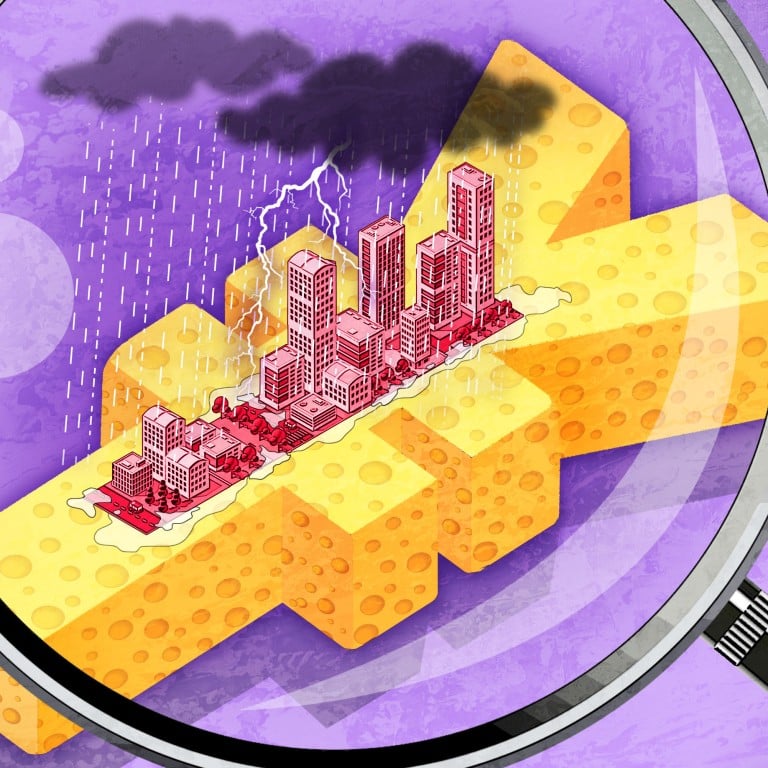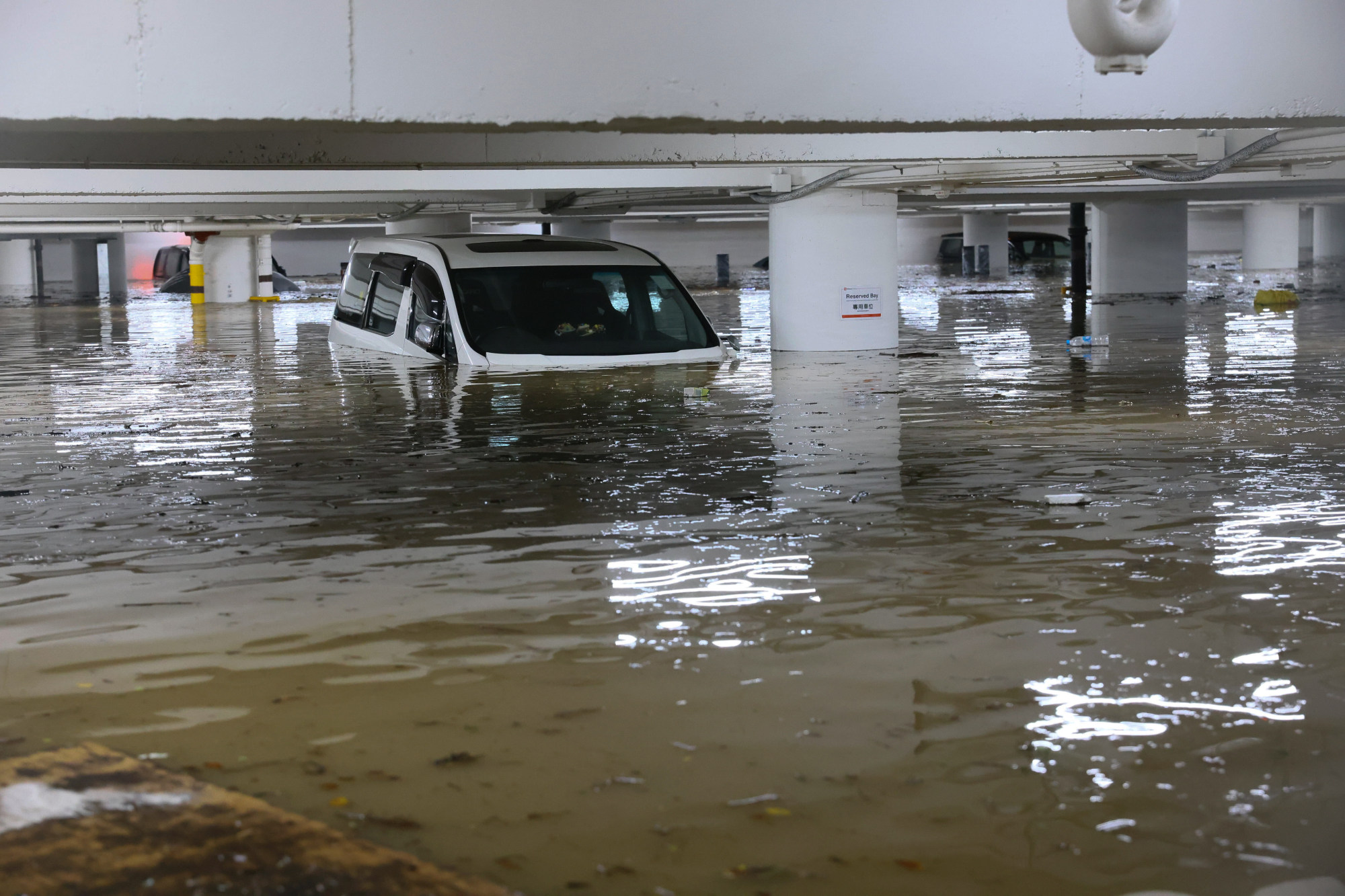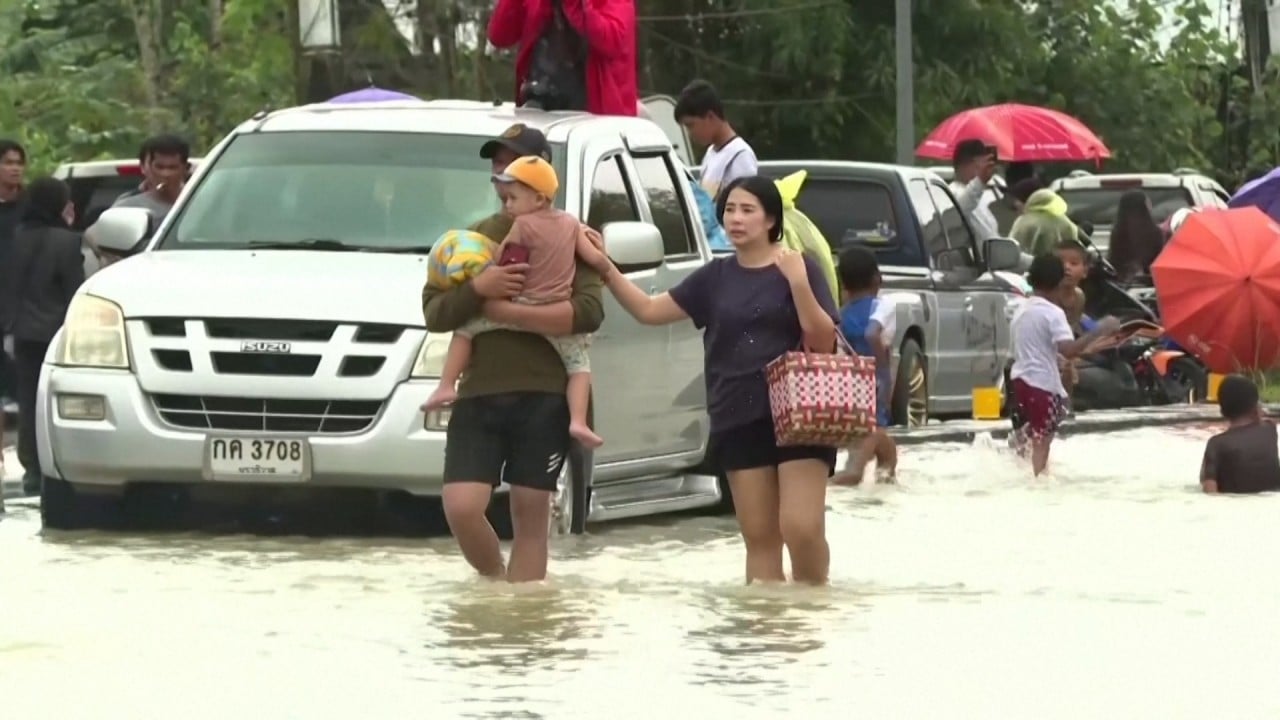
Climate change: China’s ‘sponge cities’ struggle to soak up flooding from severe storms despite billions in investment
- Chinese cities have spent more than 1 trillion yuan (US$140 billion) on infrastructure to absorb rainfall and minimise flood damage
- That is a mere drop in the bucket compared with what is needed to deal with the deluges climate change is dumping on the nation
Shenzhen resident Autumn Fang spent nearly two days at home without water or power in September when Typhoon Saola lashed southern China with record-breaking rainstorms. Near her home, people were paddling lifeboats in knee-high water to rescue stranded pedestrians.
“That’s the crossroads I walk by every day,” she said. “I’ve never seen Shenzhen like this.” Indeed, the city got hit by the heaviest rain since meteorological records began in 1952. Average rainfall across the city from the afternoon of September 7 to the next morning surpassed 200mm, while some areas received a deluge of 470mm, according to authorities.
As 2023 broke the record for the hottest year ever, with heatwaves and wildfires raging all around the world, China also suffered from several major floods, which led to direct economic losses of 32 billion yuan (US$4.5 billion) in the first three quarters.
These disasters raised questions about the effectiveness of China’s climate-resilience strategy for extreme rainfall, the “sponge city” initiative launched nationwide in 2015. Experts say that the basic idea – making cities better at absorbing excess rain – is a sound one. But its roll-out so far has turned out to be something of a damp squib. For the initiative to truly hold water, infrastructure must be deployed more rapidly. Even then it will not, on its own, protect against the most severe events that climate change is spawning, experts say.

China’s State Council, the cabinet, announced the sponge city initiative in 2015. Similar to the concept of “low-impact development” in the United States and Canada, the approach calls for more green and blue spaces, like trees, wetland parks, and lakes, to be placed among conventional infrastructure like roads and buildings. This mimics natural water cycles to allow cities to soak up rainwater, then drain it away or make use of it.
The government expected the approach to not only strengthen the country’s drainage and water-management systems to enhance urban flood prevention, but also make it an engine for economic growth. “Promote the construction of sponge cities, so that urban areas will have not just outward form but real substance,” said former premier Li Keqiang in the annual government work report in 2017.
The council set ambitious targets: equipping 80 per cent of urban areas with sponge-city features by 2030 and recycling at least 70 per cent of rainfall. The government had identified 60 cities as pilot cities as of May 2023, offering them subsidies from 700 million yuan to 1 billion yuan each.
From 2016 to 2020, cities engaged in more than 33,000 sponge-city projects, from residential communities to parks, spanning 90 cities in 13 provinces, with the total investment reaching 1.06 trillion yuan, according to state media.
Developers are on board.

The concept is “integrated into all our developments, especially the mixed-use precincts”, said Michael Long, group head of sustainability at New World Development.
“For New World, we see that the sponge city concept remains an important aspect of our strategic approach towards climate resilience and resource conservation, and also [other] aspects of protecting our natural environment, and how we integrate that into business decision-making, from new investments to development design and asset operations.”
The Canton First Estate in Foshan, a mixed-use project spanning villas, serviced apartments and a golf course by the developer’s mainland China property arm, New World China, includes drainage-improving features such as basins that collect and filter rainwater, as well as permeable pavement.
The development can process up to 4.45 million cubic metres of rainwater and greywater each year and withstand a once-in-50-years torrential rainstorm, Long said.
Despite such efforts, Chinese cities remain vulnerable. Last July, cities and provinces in northeastern China, including Beijing, Tianjin and Hebei province, experienced extreme rainfall and flooding as a result of Typhoon Doksuri. At least 1.3 million people were affected and more than 200,000 homes were damaged, according to the Beijing municipal government.
In September, Typhoon Saola hit southern China’s Fujian and Guangdong provinces after battering Hong Kong, prompting the evacuation of more than 800,000 people and the cancellation of hundreds of flights. According to the Fujian government, the event led to a direct economic loss of about 870 million yuan in the province.
Such losses pose the question: after many billions of yuan invested and nearly a decade of construction, does sponge-city infrastructure really work in protecting cities from flood damage?
According to water and engineering experts, sponge-city measures are a reasonable approach to improve resilience against heavy rainfall. Impermeable surfaces in urban areas, such as concrete, brick and steel, reduce infiltration and raise the risk of floods during storms. Sponge-city infrastructure can improve a city’s capability to absorb and store water.
“China’s actions to address floods and heavy rainfalls, especially its ‘sponge city’ initiative, are an important strategy to proactively address the challenges of contemporary urban development and climate change,” said Li Junqi, vice-principal at Beijing University of Civil Engineering and Architecture.
Malaysia floods force 25,000 to leave homes, river project slammed as useless
Many cities that have implemented the concept, such as Shanghai and Wuhan in Hubei province, have experienced less waterlogging during heavy rainfall than before, according to Li.
However, such infrastructure can only manage a certain amount of rainwater. And climate change is fuelling extreme events that exceed the levels sponge cities can handle, according to experts.
“People who think the sponge city initiative failed tend to think that there’s a silver bullet to solve the water risks,” said Mark Fletcher, global water business leader at engineering consultant Arup. “But there are no silver bullets in the fight against uncertainty and climate change.”
For example, according to statistics from the water authority of the Shenzhen Municipality, after investing more than 2.3 billion yuan from 2016 to 2022 in sponge-city projects, the city is now protected against heavy floods of the type that occur once every 100 to 200 years.
But according to Hong Kong officials, the rainstorm in September was a “once in 500 years” event.
“The challenge we’re facing is an awful lot of uncertainty with climate change,” Fletcher said. “There are really good things that we’re doing at the moment with water resilience, like sponge cities, but maybe it’s time to go to the next level, like ‘sponge city plus’, as we’re getting bigger and more extreme events.”
It is crucial to include non-structural measures, such as effective forecasting and early-warning systems, into urban flood-protection efforts, according to Fletcher.
Using advanced technologies such as artificial intelligence and big data throughout the urban planning, forecasting and early warning processes can help build different layers of resilience, he said. For example, a city can concentrate infrastructure development in problem areas, or move quickly to relocate people and equipment to minimise damage when flooding is imminent. The government should educate citizens about risks and protection methods to improve community resilience, rather than just focusing on infrastructure resilience, he said.
Swire Properties has incorporated sponge-city concepts into projects such as Taikoo Place in Hong Kong and Savyavasa in Jakarta, according to Fiona Shiu, director of the technical services and sustainability department and facilities management. A redevelopment project at Taikoo Place is expanding green space to around 35 per cent of its area, while the luxury Jakarta project has a 45 per cent greenery ratio.
Why Northern Metropolis needs the city’s wetlands to secure its future
Henderson Land, Link Reit and Sun Hung Kai Properties have also introduced similar concepts in their residential, commercial and urban renewal projects.
However, sponge-city techniques have not become standard enough in urban development, according to experts.
“There were some user cases in mainland China about how to build sponge cities and where, but my view is it did not pick up,” said Entela Benz, CEO and founder of climate risk analytics firm Intensel. “It has not become the common standard that we build cities with.”
The government and financial institutions should direct more investment into developing nature-based solutions, such as sponge-city projects, which are critical to addressing climate change but remain underinvested.
In fact, China faces significant financial shortfalls for climate-resilient infrastructure, with an annual funding gap of nearly 500 billion yuan over the next five years, according to a report published by the World Resources Institute in 2021.
The report studied returns on investment for three types of climate-resilient infrastructure, including water-saving irrigation facilities, sponge-city construction, and grey-green sea dykes. Its estimate suggests that every yuan invested can generate between 2 and 20 yuan of returns over a period of 30 years.
More people are living in flood-prone areas despite the risks, study finds
Experts stress that arresting climate change – to avoid frequent and severe natural catastrophes in the first place – is also crucial.
“Only by combining [climate] mitigation with adaptation can we minimise the adverse effects of climate change and ensure the sustainable development of human society,” said Li Zheng, professor at Tsinghua University and president of its Institute of Climate Change and Sustainable Development. “Both are indispensable.”




